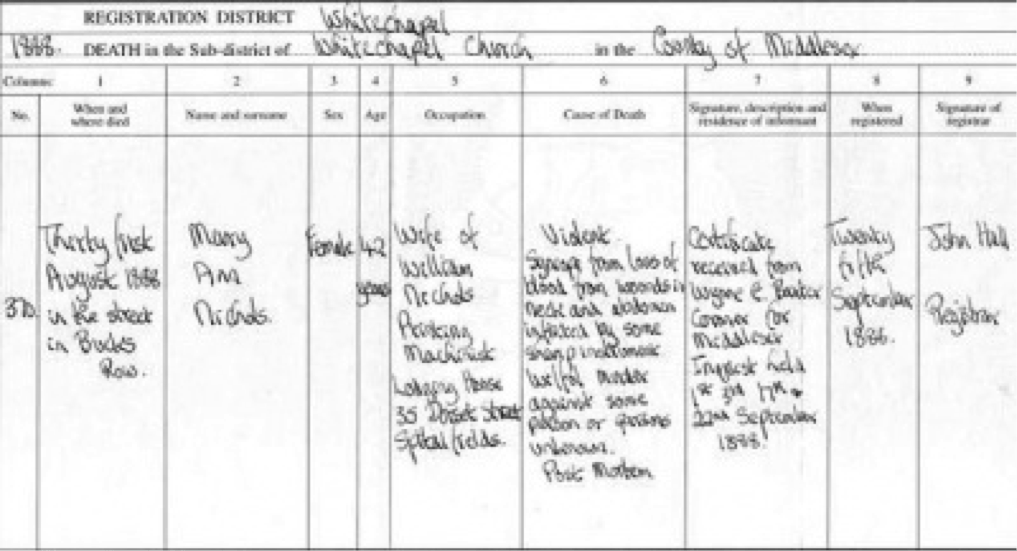Born on August 26, 1845 in London England, Mary Ann Walker was raised by locksmith Edward Walker and his wife Caroline. She married William Nichols, a printer’s machinist, in 1864; however, the couple divorced due to Mary’s drinking habits and prostitution allegations. Mary, now Mary Anne Nichols, continued practicing prostitution and was known for moving between workhouses and boarding houses, and living off charitable donations.

Prostitutes in Europe were regarded with mixed feelings in the nineteenth century. An awareness for the vulnerability of women prostitutes was fairly low and they were treated with curiosity as well as disgust. They had few economic options for making their way in the world and the women themselves were generally born into poverty and had little education or work skills. London prostitutes, especially those who operated on the streets, regularly picked the pockets of the men they preyed on. They kept an eye out for drunkards, from whom they could steal without the risk of being caught. However, this wasn’t the case with Mary as she herself spent most of her waking hours under the influence. Prostitution was very much frowned upon in London, and the women engaging in the profession were seen as the lowest of the low. It wasn’t unusual for men to beat and kill a prostitute after a ‘session,’ so when Mary Ann was found dead with her skirt lifted above her stomach, it was nothing out of the ordinary.1
The night in question was August 30, 1888. A heavy rain was falling on London during one of the coldest and wettest summers on record. Mary Ann was last seen walking down Whitechapel Road, and more than likely she was there soliciting her trade. Prostitution was a very dangerous profession one hundred thirty years ago. With no proper policing and the women themselves looked upon as animals, people would do with them as they pleased. No wonder the infamous ‘Jack the Ripper’s’ victims were all prostitutes.2 They were easy targets, and he was able to get away with murder.
Nichols was often found in the lodging house on 18 Thrawl Street; however, on this specific night she was knocked back due to a lack of money.3 Mary wasn’t fazed by this though, and was on her way back to her ‘office,’ the streets. At 2:30 am she ran into Emily Holland, another worker, who described Mary to be drunk and staggered against a wall. She told Emily that she was off to find another ‘punter’ in an attempt to get her ‘doss’ money in order to rest her head that night.4 One can’t help but think that Mary was selected by Jack because of her drunkenness and through no fault of her own she was destined to a brutal ending because she was such an easy victim. Emily Holland was the last known person to interact with Mary, and only one hour later, at 3:40 am, the latter was found cold and lifeless on the side of Bucks Row, a mere ten minutes walk from where the interaction took place.5

Constable Thain and Sergeant Kerby both passed down Bucks Row at 3:15, but reported nothing out of the ordinary. One must wonder what Nichols was doing from 2:30 to 3:40. She was only ten minutes away from Bucks Row, yet was found dead there seventy minutes later. Another thought would be: what was Jack the Ripper doing during that time. 6
Nichols’ body was initially found by two workmen, who both decided to leave her lying, as they didn’t want to be late for work. However, they let a police officer know her whereabouts on their way. Major bruising was found on Mary’s body and five of her teeth were missing. Investigators put this down to the struggle. Nevertheless, there were several deep cuts along her abdomen, which shows that her attacker enjoyed closeness with his victim, whom he supposedly raped and then mutilated. One can only speculate on why these cuts were made as they were, in no pattern, and didn’t relate to anything. As the first kill, maybe Jack was experimenting with Mary, and she was some sort of sick puppet in which his fantasies could be played out.7

Mary was buried on Thursday, September 6 of that year in the City of London’s Cemetery.8 Two days later, another of Jack’s victims, Annie Chapman, was found in the back garden of a London flat.9 Her womb had been removed and her body left horrifically mutilated. Jack the Ripper had indeed struck a second time. He wasted no time in preparing his second victim, yet this time it was more brutal than the first. One may wonder if Jack had attempted to remove Mary’s womb, but was perhaps disturbed and fled the scene before he could complete the operation.10 Jack the Ripper’s third victim was Elizabeth Stride. She was found at 1:00 am in Dutfield’s Yard, London. The fact that her throat had been cut, but the rest of her body had not been touched, led to speculation that her killer had been interrupted. This links with Mary Ann’s case because it is believed that Jack was also interrupted while working on her. One may believe that Jack liked the excitement of being caught, as he seemed to carry out his kills in the middle of streets. The fourth victim was found in Mitre Square in the City of London at 1:45 am. Catherine Eddowes was savagely mutilated by The Ripper, as her face was torn off and her uterus was missing along with her kidney. Clearly, Jack had not been interrupted this time. On November 9, the body of Mary Kelly was found in her room in Miller’s Court at 10:45 am. She had been virtually skinned to the bone and many experts believed that she was Jack the Ripper’s final victim. This was a fitting finale for the sick monster, as he chose a private area in order to carry out his most disturbing kill of all.11
For well over one hundred years since the time of the murder of Mary Ann and the rest of Jack’s victims, the identity of the killer has been regularly questioned, with nearly one hundred suspects having been named in the process. While many theories exist, none of them have proven to be indisputably convincing. Many think the Ripper was a commoner, possibly a butcher or other tradesman, who lived locally and was employed during the week, explaining why the murders occurred on or near the weekend. A lot of experts also agree that the Ripper was a local to Whitechapel. One of the most compelling suspects was Thomas Hayne Cutbush, who was a violent youth diagnosed insane at the time of the murders in 1888, and was believed to be wandering the streets of London throughout the time of the killings. Subsequently, the murders then stopped after Cutbush was locked up. Disappointingly, this information, along with more evidence, did not prove that Cutbush and Jack the Ripper were the same man; but there was enough evidence to keep Cutbush on the suspect list.12
The finger of suspicion was first pointed at Cutbush in 1894, by The Sun newspaper.13 The article claimed that despite the popular theory of the Ripper being dead, he was in fact a mental patient. The Sun’s detailed description clearly resembled that of Cutbush. The suspicion was that the Metropolitan Police covered up his guilt to avoid the embarrassing outcry that would have followed if the country’s most feared serial killer was found to be Superintendent Henry Cutbush’s nephew. Henry was a high ranked officer, whose reputation could have been seriously damaged if his relative was found to be Jack the Ripper. This is another reason why Thomas Cutbush was actively considered as a suspect.
Some named Cutbush as the No 1 Ripper suspect, but others have strongly denied this theory. Its main weakness is that the last known Ripper victim died in November 1888, at the end of the eleven week killing spree. If Cutbush was the killer, it seems odd that he would commit five murders over such short a period of time, stop for more than two years, and then commit one more assault, in which his victim survived. But there is almost no chance that the case will ever be solved. Thomas Hayne Cutbush remains top of the suspect list.14
It’s an eerie thought that this case will never be solved and even if it is, there is no one to suffer the consequences. It’s even scarier to think that there may currently still be serial killers on the run now that will also never be found and charged for their crimes. There will never be any justice for Jack the Rippers victims, but they can be certain they will never be forgotten.
- Mary Spongberg, The Body of the Female Prostitute in the Nineteenth-Century (New York, NY: New York University Press, 1997), 83-85. ↵
- Encyclopaedia Britannica, July 1998, s.v, “Jack the Ripper, English Murderer,” by John Phillip Jenkins. ↵
- Knocked back means dismissed. ↵
- A punter is a client. Doss is rent. ↵
- Stephen P. Ryder, “Casebook Jack the Ripper,” Victims: Last Addresses, August 14, 2009, 2, www.casebook.org/victims/polly.html. ↵
- Stephen P. Ryder, “Casebook Jack the Ripper.” Victims: Last Addresses, August 14, 2009, 2, www.casebook.org/victims/polly.html. ↵
- Salem Press Encyclopedia, January 2016, s.v. “Jack the Ripper,” by Cait Caffrey. ↵
- Death Certificate: no.370. 25 September, 1888. http://www.casebook.org/victims/polly.html ↵
- A back garden is a backyard. ↵
- William D. Rubenstien, “The Hunt For Jack the Ripper,” Ripper Diaries, (May 2000): 1-3. ↵
- Richard Jones, “Jack The Ripper 1888,” Victims (13 March 2016): 3. ↵
- Andy McSmith, “Madman’s notes throw new light on Ripper case,” The Independent article London, (19 November 2008). ↵
- A tabloid newspaper published in the United Kingdom and Ireland. ↵
- Richard Wheatsone, “Ripping Discovery,” The Sun (16 September 2017). ↵



211 comments
Alise Balderas
This article was very informative! I have heard of Jack the Ripper, but I did not know everything. I find it really disturbing that a common theme amongst cereal killers is their desire of solely women. The name, “Jack the Ripper”, always came up but it wasn’t until now that I actually understood where the name came from. Like I have said with other articles, it is sad to see how the things portrayed in horror movies happen in real life an di believe that it is our duty to ensure history does not keep repeating itself.
Eduardo Foster
Before the article I did not have heard of Jack or “The Ripper” before. It is impacting how he take out these women lives. It is sad how people can do these kinds of criminal acts without any mercy. I like how the story is narrated with the details. Very informative article and keep it up with the good work.
Sebastian Castro Ramos
Jack the Reaper is an iconic figure in London’s history because of his success in murdering people and not being ever caught, because of the gruesome way he murdered his victims, and just because people toady love serial killers. I think he murdered prostitutes to show his opinion about them, but it might have been because they were easy targets, since he could study his victims easily on the streets and determine a precise moment and time to murder them. Good article!
Andrea Chavez
Jack the Ripper is probably one of the most known killers throughout history without really being known. Its incredible how he could never be find out, not even years later. He is one of those few mysteries that will remain forever a mystery. I think a great deal about this is the bad way the police handled the situation, and in so never really giving it the right importance until it was to late.
Cherice Leach
I’ve heard Jack the Ripper mentioned in books and movies, but it’s eye-opening to read about how brutal he truly was. Just because Mary was a drunk and easy victim, it’s sad to think that her life choices that she made out of necessity put her in the spot she was in. It goes to show that even the choices you think are for your best interest, can lead you down a dangerous path.
Alejandra Mendez
This was a very well-written article with many interesting aspects to it. There are so many parts to the story that really raise an eyebrow. Why were those who found her so careless. It is an interesting thought to think what would happen today if what happened during Jack the Ripper’s first murder, happened now. I for one, think that those that found her would definitely be considered as suspects because they were the first coincidentally on the scene of the murder with the murderer no where in sight, and they didn’t even stay.
Briana Myers
I have heard Jack the Ripper’s name countless of times, but I never really knew what it was that he did. I knew that he was a serial killer, but I was not aware of who his victims were or the terrible things that he did to them. This is a very interesting article that deserves it nomination. I am disturbed that someone could do the things that the ripper did and never get caught. It is scary to know that there are people like this running free around the world.
Edward Cerna
This was a great article to read and it had great amounts of information and I also like the way you organized it as well. I had known about Jack the ripper before but did not know the specifics of him. This was really interesting to read as it really caught my attention and once I started reading the article wouldn’t let me leave, it was really interesting so good job.
Soteria Banks
This article really was disturbing. i don’t think those women deserved that, yes they were selling their bodies, but they don’t deserve to die . i really don’t like Jack the ripper, hes sick. This was a great article don’t get me wrong. i just hate how people can take lives away. Everyone’s life matters. Your article was very informative, i thought i knew about Jack but you informed me even more thank you for sharing.
Ryann Cervantes
Great article. I think what has made Jack the Ripper so notorious is the amount of fear he brought to the streets and how he wasn’t caught. I liked how you chose to focus on the story of the first victim and not the entire group of victims. It really helps with capturing the story better since it’s not spread out.